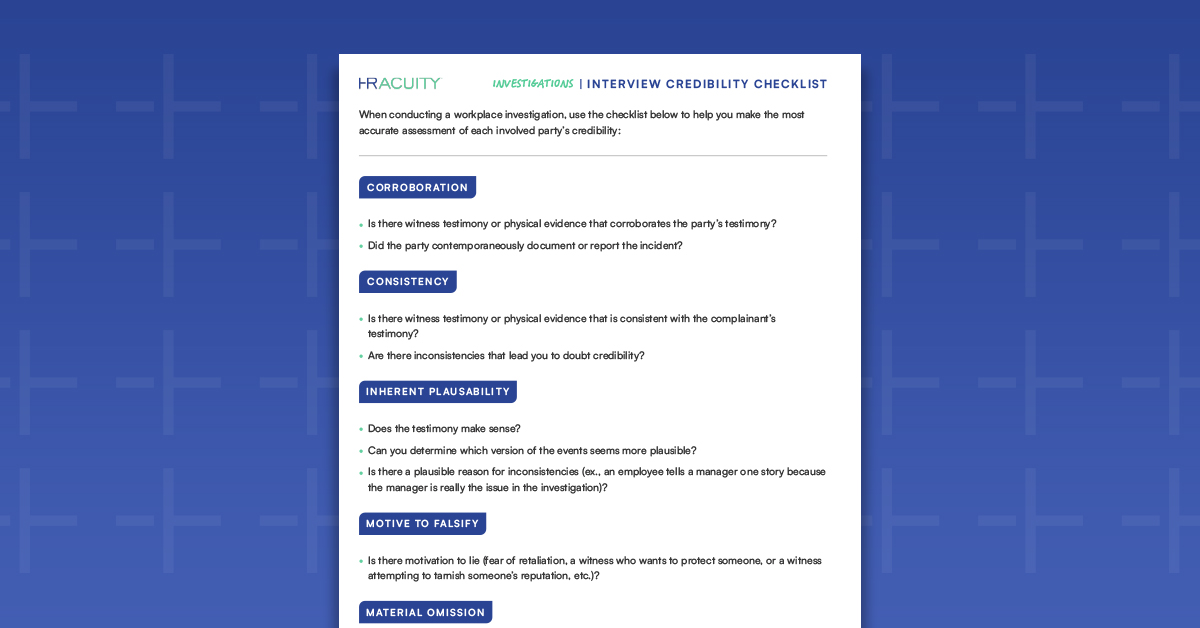What Is a Credibility Assessment in a Workplace Investigation?
Workplace investigations aren’t just about fact-gathering. The investigator’s role is to assess credibility based on all workplace investigation interviews so that the decision-maker can make an informed decision. The analytical standard for assessing credibility takes the following into account:
- Is there a preponderance of evidence based on corroborating information?
- Did the event more than likely occur?
- Does the evidence presented on one side outweigh what’s presented on the opposing side?
- Is there a greater than 50% chance that a proposition is true?
What Are the Barriers to Assessing Credibility?
Insufficient evidence is almost always the factor leading the investigator to conclude it’s impossible to make a call – the very thing that is most needed. That’s when the investigator needs to go back and ask more questions.
- Pitfalls in determining credibility:
- Confirmation bias – you know the parties, or you stop investigating because of investigator bias – you’ve decided that you think something happened in a certain way. There may also be internal bias to get the investigation completed.
- Making a determination too soon – without having sufficient information.
- Failing to make a determination – also a case where you haven’t obtained enough information. You will need to ask more questions or talk to more witnesses.
What Credibility Factors Are the Most Reliable in a Workplace Investigation?
- The most reliable credibility factors (Gold Standard) when you’re struggling to decide who is telling the truth:
- Corroboration – Witness testimony, text message or email exchanges, video or photo evidence, also assessing reliability of testimony with a witness’s recollection of events
- Consistency – Is there witness testimony or physical evidence that is consistent with the complainant’s testimony? Or are there inconsistencies that make you doubt credibility?
- Inherent plausibility – Does the testimony make sense? Which version of the events seems more plausible? Is there a plausible reason for inconsistencies (ex., an employee tells a manager one story because the manager is really the issue in the investigation)?
- Motive to falsify – Is there motivation to lie (fear of retaliation, a witness who wants to protect someone, etc.)?
- Material omission – Did someone omit something that was important, despite having an opportunity to provide the information?
6 Credibility Assessment Strategies for Workplace Investigations
A thorough investigator has the responsibility to analyze the facts as uncovered, assess the credibility of the parties involved and come to some reasonable determination – even in a “he said, she said” situation.
Download Our Investigation Interview Credibility Checklist

Create a Timeline of Events
We need to understand what happened and when. Ask both parties to share a sequence of events and if or when any feedback was provided. Look at the timing of when the offending behavior began compared to when the complaint occurred.
Assess the Believability of Indirect Parties
Figure out who was told about the situation. Did either of the parties tell HR or a manager? What did they say? Why or why not did they choose to tell someone?
Corroborate What Did or Didn’t Happen
Documentation is key for any investigation. Request and assess any performance-related documentation, noting how it fits into the timeline of events. If no documentation is available regarding changes in employee performance, ask why.
Evaluate the Logic of Each Party’s Story
Does what you’re hearing make sense? Compare the explanation to the timeline of events and evaluate the logic of the person’s actions relative to the story.
Utilize Technology to Corroborate Important Investigation Information
Look for evidence, such as emails, text messages, or other records supporting one party’s statement. Was there a change in tone or a difference in what was sent to other team members?
Looking for Consistency or Contradiction of The Facts
Get specific details about what happened. Ask questions like, “Where were they standing?” and “What did you do when you left?” If someone denies it, ask them for evidence and ask the other party for any proof that it did happen.
Workplace Investigation Interview Tips
Conducting interviews is perhaps the most important element of any workplace investigation. This means it’s critical that HR professionals use strong techniques and maintain the proper atmosphere during these interactions. With that in mind, here are a few tips investigators should keep in mind when performing a workplace investigation interview:
- Keep questions simple — The more complicated the question is, the more likely the interviewee will become confused and give compromised testimony. Questions should be short and aimed at collecting one detail at a time. Asking a number of relatively simple follow-up questions will yield better results than trying to have a witness tell the entire story in one chunk. Check out our list of questions to ask during an investigation interview for more tips.
- Avoid leading questions — Questions that begin with an assumption of guilt or innocence can lead to trouble down the line. Rather than asking a question such as, “Did you overhear your coworker use a racial slur?” use a neutral phrasing. For example, “What do you remember your coworker saying?”
- Keep your body language and mood neutral — Without knowing it, investigators may compromise their workplace investigations through the way they conduct themselves during interviews. They should avoid nodding, smiling, frowning, or otherwise giving off signals that they approve or disapprove of what the interviewee is saying. Some employees may unconsciously alter their testimony if they feel the interviewer is on their side or not.
- Keep interviewees comfortable — A workplace investigation needs the full cooperation of witnesses to be successful. This means it’s up to the interviewer to ensure all those being interviewed feel comfortable to speak freely and answer questions as truthfully as possible. They can do this by making small talk at the onset of the interview and keeping the questioning as simple as possible. By avoiding complex questions, it’s easier for interviewees to stay focused on delivering accurate testimony.
- Think back to previous employment — During a job interview, you’ll ask your candidate about a three-year gap in employment. Do you believe what she tells you? Does what she’s telling you make sense? Consider the same when an involved party in your investigation explains how they couldn’t possibly have behaved in the way that was alleged. Is the explanation consistent with your other facts? Is it logical or even plausible?
- Seek out past references — Conduct background checks when making a staffing selection to back up what candidates tell us in interviews. No difference in an investigation. Find the documents or the individuals that can corroborate, or in some cases, contradict, what you have been told.
- Ask them to describe some specific tasks they supposedly performed in a previous role — If they can’t remember any details… makes you wonder, doesn’t it? Funny thing is those sudden memory lapses. No different from when an involved party in an investigation “forgets” to tell you about a recent and relevant conversation or email.
- Look at records of successes or failures when evaluating candidates for open positions — Don’t forget to do the same thing as part of your investigation. Look at employment history, previous issues and warnings.
Learn More About Assessing Credibility
These are just some of the highlights of the webinar, but you’ll want to watch the complete webinar on-demand here – everyone can use a refresher on the topic of how to best assess credibility in workplace investigations!
If you are interested in learning more about how HR Acuity drives qualitative improvements in workplace investigations, contact us. HR Acuity’s thought leadership, experience, implementation and ongoing support models give our clients valuable insights into areas such as credibility assessments, and they differentiate HR Acuity’s employee relations risk mitigation solution from other IT-based applications on the market today.
Related resources:


